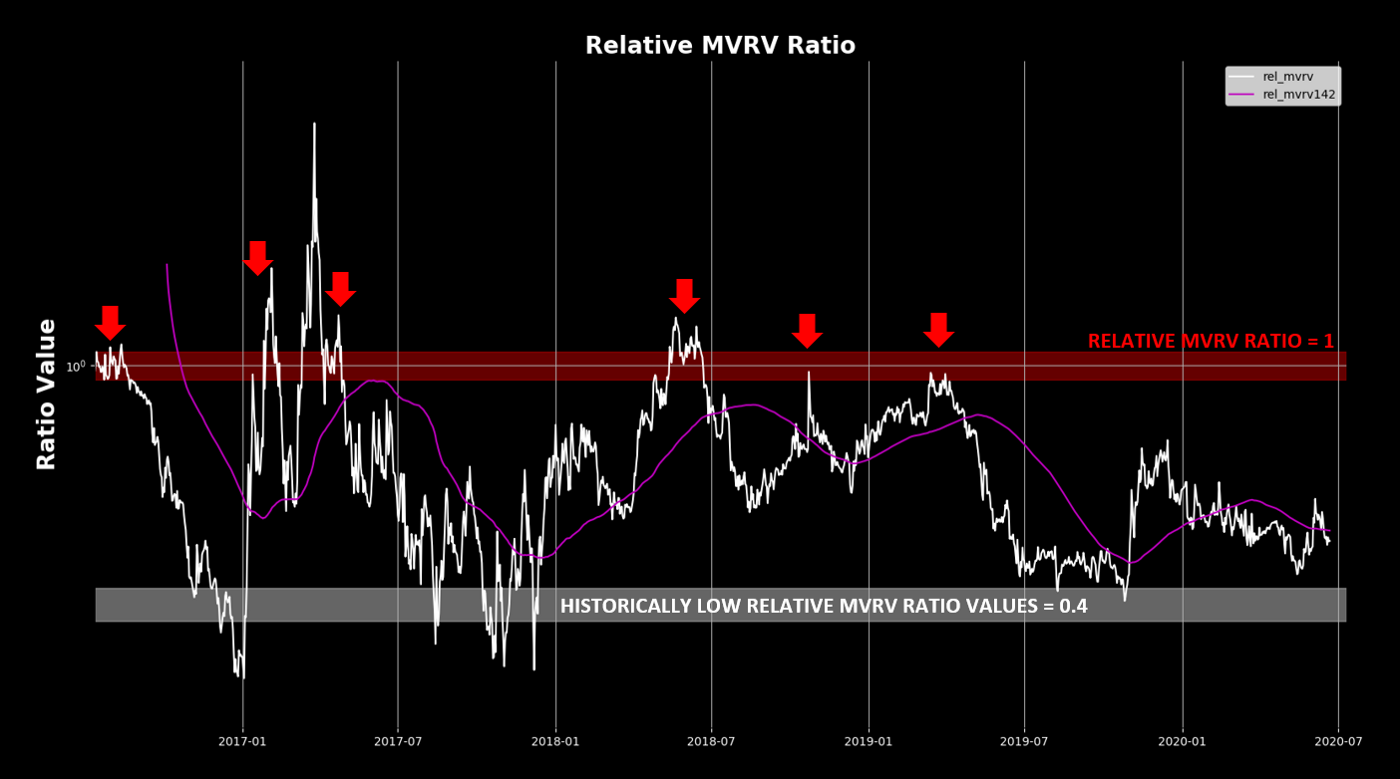Decred On-Chain Mini Pub 1: Relative MVRV Ratio
Spending within the cryptocurrency space is one of the most deliberate financial acts somebody can commit to. This naturally emerges as a function of the fact that transactions cannot be reversed

By Permabull Nino - Jul 1, 2020 - A Comparative Look at Decred and Bitcoin’s Realized Caps
Relevant Reading
Rationale
For those unfamiliar with the Realized Cap, please read the linked piece above as Checkmate did a rockstar job in formalizing the power behind the Realized Cap, how Bitcoin’s differs from Decred’s, and how this manifests itself in price action for each respective coin. For those more comfortable with the abbreviated version, a summary of relevant points surrounding the Realized Cap are included below:
- Realized Cap: Network value calculated by price at which UTXOs were last spent (as opposed to current exchange-traded price)
- Realized Cap: On-chain cost basis of network participants
- MVRV Ratio = Market Cap / Realized Cap
- Bitcoin’s Realized Cap is slow-moving and rarely collides with Market Cap
- Whenever Bitcoin’s Market Cap < Bitcoin’s Realized Cap, it’s historically a great buying opportunity
- Decred’s Realized Cap is dynamic and moves closely with Market Cap
- Decred’s Realized Cap provides ultimate bull support / bear resistance depending on market conditions
- The difference in Realized Cap behaviors is a result of the fact that HODLers in Bitcoin rarely move their coins, whereas Decred HODLers’ coins are constantly on the move via tickets (i.e. staking)
With the above in mind, the tools presented within aim to establish the following:
- We have a relative market traded price for Decred vs Bitcoin (DCR/BTC), but lack a relative on-chain price — this can provide useful information
- Comparing Bitcoin / Decred MVRV Ratios can shed some light on the premiums / discounts these coins can trade against their on-chain price, and how these premiums / discounts stack up against one another
- Tracking the trend of the MVRV Ratio can provide users with valuable data the premium / discount between market-traded and on-chain price
On-Chain Toolkit
Relevant tools for analysis with their respective calculations are included below:
On-Chain DCRBTC Price: Compares the cost basis of each chain, and provides a network vs network “opportunity cost” value
Relative MVRV Ratio: Compares the premium / discount of Market Price vs Realized Price across coins
Relative MVRV Price: The DCRBTC price at which the MVRV Ratios between Bitcoin and Decred are equal (DCR MVRV / BTC MVRV = 1)
Relative Mid-Point: The mid-point between (1) On-Chain DCRBTC Price and (2) Relative MVRV Price
Relative MVRV Average: The 142 day (number of days it takes for an unvoted DCR ticket to expire) average of the Relative MVRV Ratio
Why Do These Tools Matter?
Spending within the cryptocurrency space is one of the most deliberate financial acts somebody can commit to. This naturally emerges as a function of the fact that transactions cannot be reversed once they’ve been included in a block that gets onto the consensus chain — the slightest mistake doesn’t have any recourse / means to recover. At a psychological level, this is a significant line in the sand: when coins move, the owner has decided that the risk of a mistake in coin movement is worth it for the potential reward (i.e. the reason the owner is moving the coins).
In Bitcoin, HODLers coins do not move frequently — giving us less frequent updates on their psychological outlook. On the Decred chain, we receive this signal for intent incredibly frequently, with HODLers coins moving around in the ticket system.
By comparing Realized Caps and MVRV Ratios we are exploring relative psychology between networks, and where periods of relative fear / euphoria are likely kicking in for stakeholders by analyzing the market traded price versus its on-chain values.
Charts + Analysis



- Note: ~4 years of data included in the charts above
- Decred has an elegant Relative Value Channel (the space between the On-Chain DCRBTC Price and the Relative MVRV Price), containing the large majority of DCRBTC’s ~4 years of price action
- DCRBTC price action has historically been contained on the upside by the Relative MVRV Price, showing Bitcoin defending its relative on-chain premium vs Decred
- On-Chain DCRBTC price has provided historical support on many occasions, as in theory it should reflect the minimum fair DCRBTC price
- DCRBTC price moving below the Relative Value Channel can be used as a signal for temporary price dislocation, with price trading below fundamental (on-chain) implied value
- Relative Mid-Point has provided DCRBTC support in bull trends and resistance in downtrends, as it represents an on-chain psychological line in the sand
- Relative MVRV Average has historically provided a response bull / bear line, giving users potential early breakout / breakdown signals
- LTCBTC doesn’t respect its relative value channel the same way Decred does
- Every macro LTCBTC top has been nailed by collisions between the LTCBTC market price and the LTCBTC Relative MVRV Price, showing Bitcoin defending its on-chain premium once again
- The inclusion of the Litecoin chart shows (1) Bitcoin historically defending its MVRV ratio versus other coins as well and (2) Decred stands in unique ground with the tidiness of its Relative Value Channel prints
Final Point
Bitcoin and Decred have high signal, yet different behaving Realized Caps as a function of their respective blockchain mechanics. The goal of this piece was to help highlight some of these differences, and how it plays out on the price charts.
In particular, Decred’s Realized Cap is one of a kind — the amount of valuable data it provides surrounding stakeholders is second to none. I likely have one more piece on this in the pipeline, and look forward to checking back on my findings.
Until then — signing out.





Comments ()